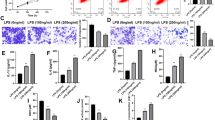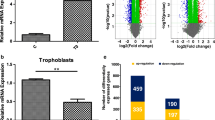Abstract
Objective
Decay-accelerating factor (DAF) is a complement regulatory protein that prevents complement-mediated cell lysis. Its expression in human trophoblasts depends on their anatomic location and gestational age. The mechanisms that govern the regulation of its expression in trophoblasts are not understood. The objective of the present study was to investigate the effects of trophoblast differentiation and cyclic adenosine monophosphate (cAMP) on DAF expression.
Methods
Human trophoblasts were isolated from chorionic villi, cultured, and harvested at timed intervals for total RNA extraction and Northern analysis. Expression of DAF was also assessed by immunocytochemistry. In some cultures, the trophoblasts were exposed to the cAMP agonists 8-bromo-cAMP and Sp-cAMPs or the antagonist Rp-cAMPs.
Results
Expression of DAF mRNA increased as the cells differentiated in culture, with the 2.2-kb transcript of membrane-bound DAF appearing first. As differentiation proceeded, the 1.5-kb transcript became the predominant mRNA form. Exposure of the cells to Rp-cAMPs delayed this process; 8-bromo-cAMP accelerated it. Sp-cAMPs selectively up-regulated the 2.2-kb mRNA transcript. Immunocytochemistry confirmed the effects of differentiation on DAF protein expression.
Conclusion
Expression of DAF in human trophoblasts is dependent on the state of cell differentiation, and cAMP is an intracellular modulator of this process. This effect may be mediated through alternative processing of DAF mRNA in its 3′ UT region, which in turn affects mRNA stability.
Similar content being viewed by others
References
Benirschke K, Kaufman P. Pathology of the human placenta, 2nd ed. New York; Springer-Verlag, 1990:13–21.
Davies M, Browne CM. Anti-trophoblast antibody responses during normal human pregnancy. J Reprod Immunol 1985;7:285–97.
Holmes CH, Simpson KL, Wainwnght SD, et al. Preferential expression of the complement regulatory protein decay accelerating factor at the fetomaternal interface during human pregnancy. J Immunol 1990;144:3099–105.
Hsi B-L, Hunt JS, Atkinson JP. Differential expression of complement regulatory proteins on subpopulations of human trophoblast cells. J Reprod Immunol 1991;19:209–23.
Tedesco F, Narchi G, Radillo O, Men S, Ferrone S, Betterle C. Susceptibility of human trophoblast to killing by human complement and the role of the complement regulatory proteins. J Immunol 1993;151:1562–70.
Caras IW, Davitz MA, Rhee L, Weddell G, Martin DW, Nussenzweig V. Cloning of decay-accelerating factor suggests novel use of splicing to generate two proteins. Nature 1987;325:545–9.
Nicholson-Weller A, Bürge J, Fearon DT, Weller PF, Austen KF. Isolation of a human erythrocyte membrane glycoprotein with decay-accelerating activity for C3 convertases of the complement system. J Immunol 1982;129:184–9.
Cunningham DS, Tichenor JR Jr. Decay-accelerating factor protects human trophoblast from complement-mediated attack. Clin Immunol Immunopathol 1995;74:156–61.
Holmes CH, Simpson KL, Okada H, et al. Complement regulator)’ proteins at the feto-maternal interface during human placental development: Distribution of CD59 by comparison with membrane cofactor protein (CD46) and decay accelerating factor (CD55). Eur J Immunol 1992;22:1579–85.
Nishikon K, Noma J, Hirakawa S, Amano T, Kudo T. The change of membrane complement regulatory protein in chorion of early pregnancy. Clin Immunol Immunopathol 1993;69:167–74.
Hill JA, Melling GC, Johnson PM. Immunohistochemical studies of human uteroplacental tissues from first-trimester spontaneous abortion. Am J Obstet Gynecol 1995;173:90–6.
Kliman HJ, Nestler JE, Sermasi E, Sanger JM, Strauss JF III. Purification, characterization, and in vitro differentiation of cyto-trophoblasts from human term placentae. Endocrinology 1986;118:1567–82.
Babalola GO, Coutifaris C, Soto EA, Kliman HJ, Shuman H, Strauss JF III. Aggregation of dispersed human cytotrophoblastic cells: Lessons relevant to the morphogenesis of the placenta. Dev Biol 1990;137:100–8.
Coutifaris C, Babalola GO, Abisogun AO, et al. In vitro systems for the study of human trophoblast implantation. Ann NY Acad Sci 1991;622:191–201.
Thomas DJ, Lublin DM. Identification of 5’-flanking regions affecting the expression of the human decay accelerating factor gene and their role in tissue-specific expression. J Immunol 1993;150:151–60.
Kao L-C, Babalola GO, Kopf GS, Coutifans CS, Strauss III JF. Differentiation of human trophoblasts: Structure-function relationships. In: Leung PCK, Hsueh AJW, Friesen HG, eds. Molecular basis of reproductive endocrinology. New York: Spnnger-Verlag, 1993:159–70.
Kinoshita T, Medof ME, Silber R, Nussenzweig V. Distribution of decay-accelerating factor in the peripheral blood of normal individuals and patients with paroxysmal nocturnal hemoglobinuria. J Exp Med 1985;162:75–92.
Sambrook J, Fritsch EG, Maniatis T. Molecular cloning: A laboratory manual. 2nd ed. Plainview, New York: Cold Spring Harbor Laboratory Press, 1989:719–25, 739-52.
Medof ME, Lublin DM, Holers VM, et al. Cloning and characterization of cDNAs encoding the complete sequence of decay-accelerating factor of human complement. Proc Natl Acad Sci USA 1987;84:2007–11.
Ringler GE, Strauss HI JF. In vitro systems for the study of human placental endocrine function. Endocr Rev 1990;11:105–23.
Hasty LA, Lambris JD, Lessey 13A, Pruksananonda K, Lyttle CR. Hormonal regulation of complement components and receptors throughout the menstrual cycle. Am J Obstet Gvnecol 1994;170:168–75.
Smith CWJ, Patton JG, Nadal-Ginard B. Alternative splicing in the control of gene expression. Annu Rev Genet 1989;23:527–77.
Maniatis T. Mechanisms of alternative pre-mRNA splicing. Science 1991;251:33–4.
Erneux C, Van Sande J, Jastorff B, Dumont JE. Modulation of cyclic AMP action in the dog thyroid by its agonist and antagonist Sp- and Rp-adenosine 3’,5’-monophosphorothioate. Bio-chem J 1986;234:193–7.
Kozak M. Regulation of protein synthesis in virus infected animal cells. Adv Virus Res 1986;31:229–92.
Brawerman G. Determinants of messenger RNA stability. Cell 1987;48:5–6.
Gil G, Smith JR, Goldstein JL, Brown MS. Optional exon in the 5’-untranslated region of 3-hydroxy-3-methylglutaryl coenzyme A synthase gene: Conserved sequence and splicing pattern in humans and hamsters. Proc Natl Acad Sci USA 1987;84:1863–6.
Ladner MB, Martin GA, Noble JA, et al. Human CSF-1: Gene structure and alternative splicing of mRNA precursors. EMBO J 1987;6:2693–8.
Levy JR, Hannah S, Mooney RL, Hug V, Stevens W. Sequence and functional characterization of the terminal exon of the human insulin receptor gene. Biochim Biophys Acta 1995;1263:253–7.
Author information
Authors and Affiliations
Additional information
Drs. Zarkadis and Omigbodun contributed equally to the work reported in this manuscript.
This study was supported by National Institutes of Health grants HD-30475 (CC), HD-06724 (CC), and AI-30040 (JDL), and by the Rockefeller Foundation.
Rights and permissions
About this article
Cite this article
Zarkadis, I.K., Omigbodun, A., Forson, A. et al. Differentiation-Dependent Changes in Human Trophoblast Expression of Decay-Accelerating Factor Are Modulated by 3′,5′ Cyclic Adenosine Monophosphate. Reprod. Sci. 4, 47–53 (1997). https://doi.org/10.1016/S1071-5576(96)00061-5
Published:
Issue Date:
DOI: https://doi.org/10.1016/S1071-5576(96)00061-5




